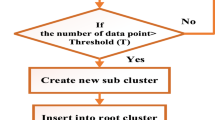Abstract
This study intends to propose a feed-forward neural network for RFID positioning system. The proposed network integrates artificial immune network for optimization (Opt-aiNET) and artificial immune system (AIS) with clone selection to train the connecting weights of feed-forward neural network. It is able to learn the relationship between the received signal strength indication and picking cart position. Since the proposed learning algorithm owns both the merits of Opt-aiNET and AIS with clone selection, it is able to avoid falling into the local optimum and possesses the learning capability. The computational results for learning two continuous functions show that the proposed algorithm has better performance than other immune-based back-propagation neural network. In addition, the model evaluation results also indicate that the proposed algorithm really can predict the picking cart position more correctly than other methods.





Similar content being viewed by others
References
Aydin, I., Karakose, M., & Akin, E. (2012). An adaptive artificial immune system for fault classification. Journal of Intelligent Manufacturing, 23(5), 1489–1499.
Ceravolo, F., Felice, M. D., & Pizzuti, S. (2009). Combining back-propagation and genetic algorithms to train neural networks for ambient temperature modeling in Italy. Lecture Notes in Computer Science, 5484, 123–131.
Chawla, V., & Ha, D. S. (2007). An overview of passive RFID. IEEE Communications Magazine, 45(9), 11–17.
Chen, M. H., Chang, P. C., & Lin, C. H. (2013). A self-evolving artificial immune system II with T-cell and B-cell for permutation flow-shop problem. Journal of Intelligent Manufacturing. doi:10.1007/s10845-012-0728-4.
Cheng, C. Y., & Prabhu, V. (2013). An approach for research and training in enterprise information system with RFID technology. Journal of Intelligent Manufacturing, 24(3), 527–540.
De Castro, L. N., & Von Zuben, F. J. (2001a). aiNET: An artificial immune network for data analysis. International Journal of Computation Intelligence and Application, 1(3), 231–259.
De Castro, L. N., & Von Zuben, F. J. (2001b). “An immunological approach to initialize feedforward neural network weights”, Artificial Neural Nets and Genetic Algorithm, 126–129.
Hart, E., & Timmis, J. (2008). Application areas of AIS: The past, the present and the future. Applied Soft Computing, 8(1), 191–201.
Hightower, J., Borriello, G., & Want, R. (2000). SpotON: An indoor 3D location sensing technology based on RF signal strength In: Seattle: University of Washington, Department of Computer Science and Engineering.
Hunt, J. E., & Cooke, D. E. (1996). Learning using an artificial immune system. Journal of Network and Computer Applications, 19(2), 189–212.
Landt, J. (2005). The history of RFID. IEEE Protentials, 24(4), 8–11.
Li, J. B., & Chung, Y. K. (2005). A novel back-propagation neural network training algorithm designed by an ant colony optimization. IEEE/PES Transmission and Distribution Conference and Exhibition: Asia and Pacific, pp. 1–5.
Lin, S. W., Chen, S. C., Wu, W. J., & Chen, C. H. (2009). Parameter determination and feature selection for back-propagation network by particle swarm optimization. Knowledge and Information Systems, 21(2), 249–266.
Lin, S. W., Tseng, T. Y., Chou, S. Y., & Chen, S. C. (2008). A simulated-annealing-based approach for simultaneous parameter optimization and feature selection of back-propagation networks. Expert Systems with Applications, 34(2), 1491–1499.
Ni, L. M., Liu, Y., Lau, Y. C., & Patil, A. P. (2004). LANDMARC: Indoor location sensing using active RFID. Wireless Networks, 10(6), 701–710.
Pasti, R., & De Castro, L. N. (2006). An immune and a gradient-based method to train multi-layer perceptron neural networks. International Joint Conference on Neural Networks, pp. 2075–2082.
Qiu, X., & Lau, H. Y. K. (2012). An AIS-based hybrid algorithm for static job shop scheduling problem. Journal of Intelligent Manufacturing. doi:10.1007/s10845-012-0701-2.
Ramaswamy, S. A. P., Venayagamoorthy, G. K., & Balakrishnan, S. N. (2007). Optimal control of class of non-linear plants using artificial immune systems: Application of the clonal selection algorithm. In IEEE International Symposium on Intelligent Control (pp. 249–254). Singapore.
Ranky, P. G. (2006). An introduction to radio frequency identification (RFID) methods and solutions. Assembly Automation, 26(1), 28–33.
Rumelhart, D. E., Hinton, G. E., & Williams, R. J. (1986). Learning representations by back-propagating errors. Nature, 323(6088), 533–536.
Salama, A. M. A., & Mahmoud, F. I. (2009). Using RFID technology in finding position and tracking based on RSSI. In International conference on advances in computational tools for engineering applications, Zouk Mosbeh, Lebanon, 15–17, 532–536.
Satapathy, J.K. & Subhashini, K.R. (2008). Tabu based back propagation algorithm for performance improvement in communication channels. In TENCON 2008–2008 IEEE Region 10 Conference (pp. 1–6).
Shepard, S. (2005). RFID: Radio frequency identification (pp. 55–63). New York: McGraw-Hill.
Tian, J., Li, M., & Chen, F. (2010). Dual-population based coevolutionary algorithm for designing RBFNN with feature selection. Expert Systems with Applications, 37(10), 6904–6918.
Timmis, J., & Edmonds, C. (2004). A comment on opt-AiNET: An immune network algorithm for optimisation. Genetic and Evolutionary Computation, 3102, 308–317.
Tuzkaya, G., Gülsün, B., Tuzkaya, U. R., Onut, S., & Bildik, E. (2013). A comparative analysis of meta-heuristic approaches for facility layout design problem: A case study for an elevator manufacturer. Journal of Intelligent Manufacturing, 24(2), 357–372.
Ülker, E., Emin Turanalp, M., & Selçuk Halkaci, H. (2009). An artificial immune system approach to CNC tool path generation. Journal of Intelligent Manufacturing, 20(1), 67–77.
Whigham, P. A., Dick, G., & Recknagel, F. (2006). Exploring seasonal patterns using process modelling and evolutionary computation. Ecological Modelling, 195(1–2), 146–152.
Zhang, Y., Jiang, P., Huang, G., Qu, T., Zhou, G., & Hong, J. (2012). RFID-enabled real-time manufacturing information tracking infrastructure for extended enterprises. Journal of Intelligent Manufacturing, 23(6), 2357–2366.
Zhou, J., & Shi, J. (2009). RFID localization algorithms and applications–a review. Journal of Intelligent Manufacturing, 20(6), 695–707.
Acknowledgments
This study is financially supported by National Science Council of Taiwan Government under contract number NSC99-2221-E-011-057-MY3. Her support is appreciated.
Author information
Authors and Affiliations
Corresponding author
Rights and permissions
About this article
Cite this article
Kuo, R.J., Chang, J.W. Intelligent RFID positioning system through immune-based feed-forward neural network. J Intell Manuf 26, 755–767 (2015). https://doi.org/10.1007/s10845-013-0832-0
Received:
Accepted:
Published:
Issue Date:
DOI: https://doi.org/10.1007/s10845-013-0832-0




